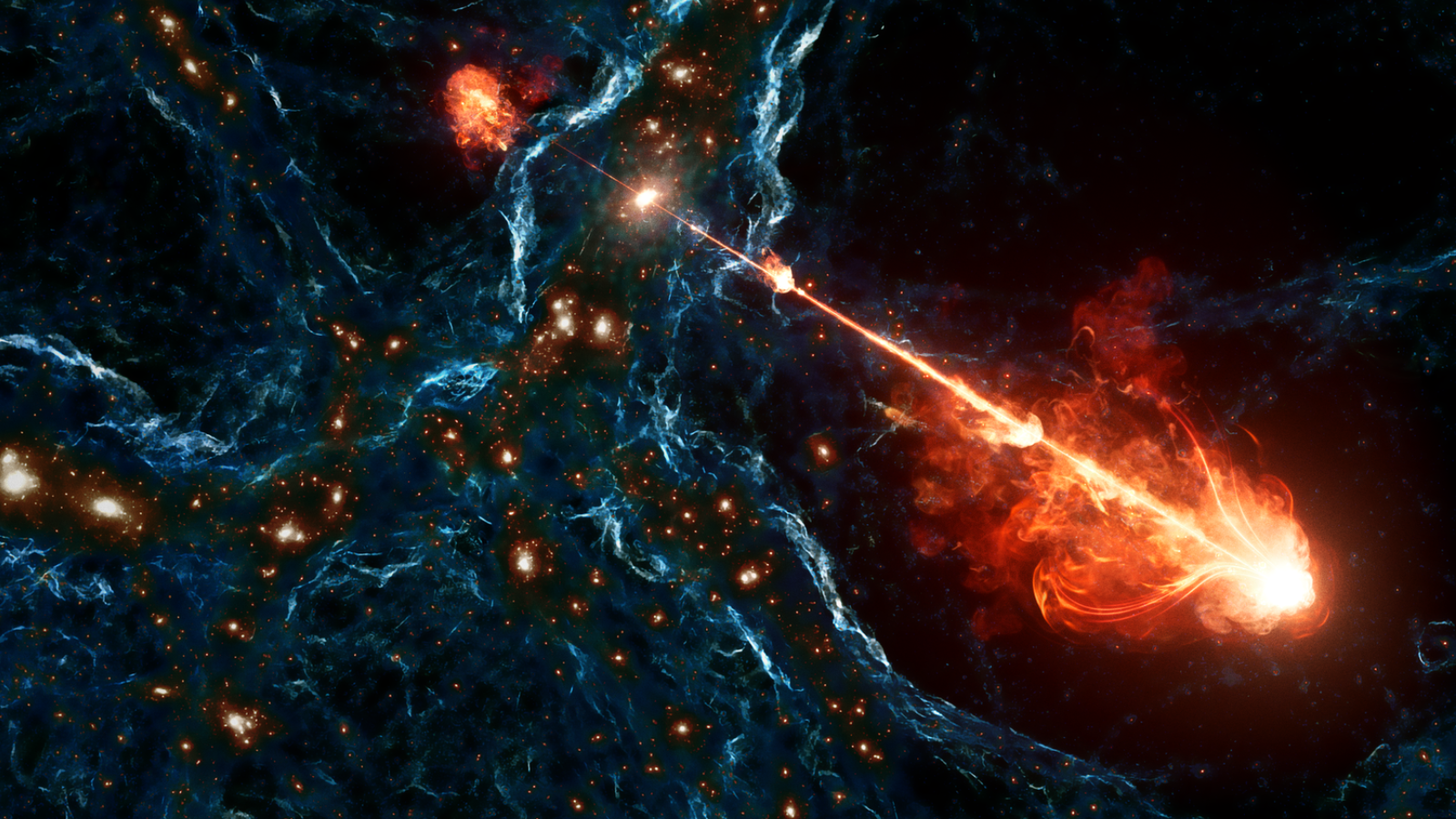
Astronomers have spotted the largest twin jets ever seen erupting from a black hole. The jets stretch for around 23 million light-years, well beyond the limits of their host galaxy and stretching as long as 140 Milky Way galaxies lined up from end to end.
The jets are erupting from a supermassive black hole at the heart of a galaxy located around 7.5 billion light-years away, meaning they are seen as they were when the 13.8 billion-year-old universe was just 6.3 billion years old, around half its current age. The jets that blast out from above and below the black hole put out trillions of times more energy per second than our sun does.
"We've known about these structures made by jets from galactic-center supermassive black holes for a long time, but this particular one stands out for three reasons," team member Martin Hardcastle of the University of Hertfordshire told Space.com. "First, it's the largest yet, at over 20 million light years from end to end, which means it goes from the center of its parent galaxy right out into the void between galaxies and galaxy groups.
"Secondly, it's one of the most powerful we know about, with a fast rate of matter infall onto the black hole. And finally, it is found when the universe was only roughly half of its present age, and is thought to have been a much more violent place with much more going on that could have disrupted the jets."
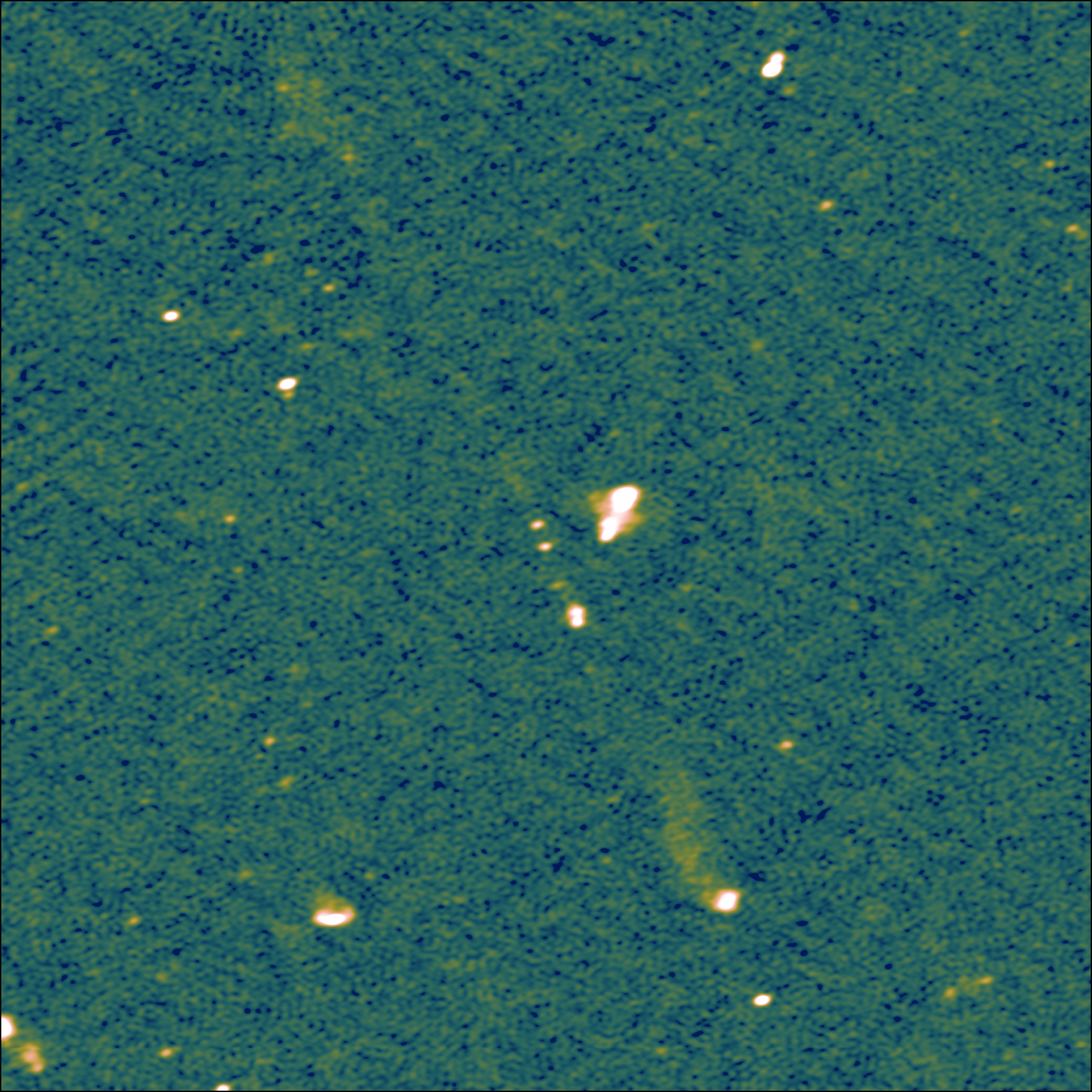
The gigantic jets have been given a suitably mythic name, with the team that discovered the megastructure dubbing them "Porphyrion" in reference to the giant offspring of Gaia in Greek mythology. Porphyrion was the greatest of the giants alongside Alcyoneus, who lends his name to the next largest set of black hole jets, which were discovered in 2022 by the same team of scientists and span the equivalent of around 100 Milky Ways.
The discovery of such a large system of black hole jets, detailed in a paper published today (Sept. 18) in the journal Nature, indicates to researchers that such outflows may have influenced the evolution of galaxies in the early universe to a far, far greater extent than previously suspected.
"Astronomers believe that galaxies and their central black holes co-evolve, and one key aspect of this is that jets can spread huge amounts of energy that affect the growth of their host galaxies and other galaxies near them," team member George Djorgovski, professor of astronomy and data science at the California Institute of Technology (Caltech) said in a statement. "This discovery shows that their effects can extend much farther out than we thought."
Black hole jets are unexpectedly long in the early universe
Hardcastle and colleagues discovered Pophyrion using the LOw Frequency ARray (LOFAR) radio telescope. This European instrument has been conducting a sky survey that has thus far revealed a vast array of over 10,000 of these faint megastructures. This is a number that has shocked astronomers because though hundreds of these large jet systems had been uncovered prior to the LOFAR observations, astronomers had still considered them relatively rare.
"Giant jets were known before we started the campaign, but we had no idea that there would turn out to be so many," Hardcastle said. "Usually, when we get a new observational capability, such as LOFAR's combination of wide field of view and very high sensitivity to extended structures, we find something new, but it was still very exciting to see so many of these objects emerging."
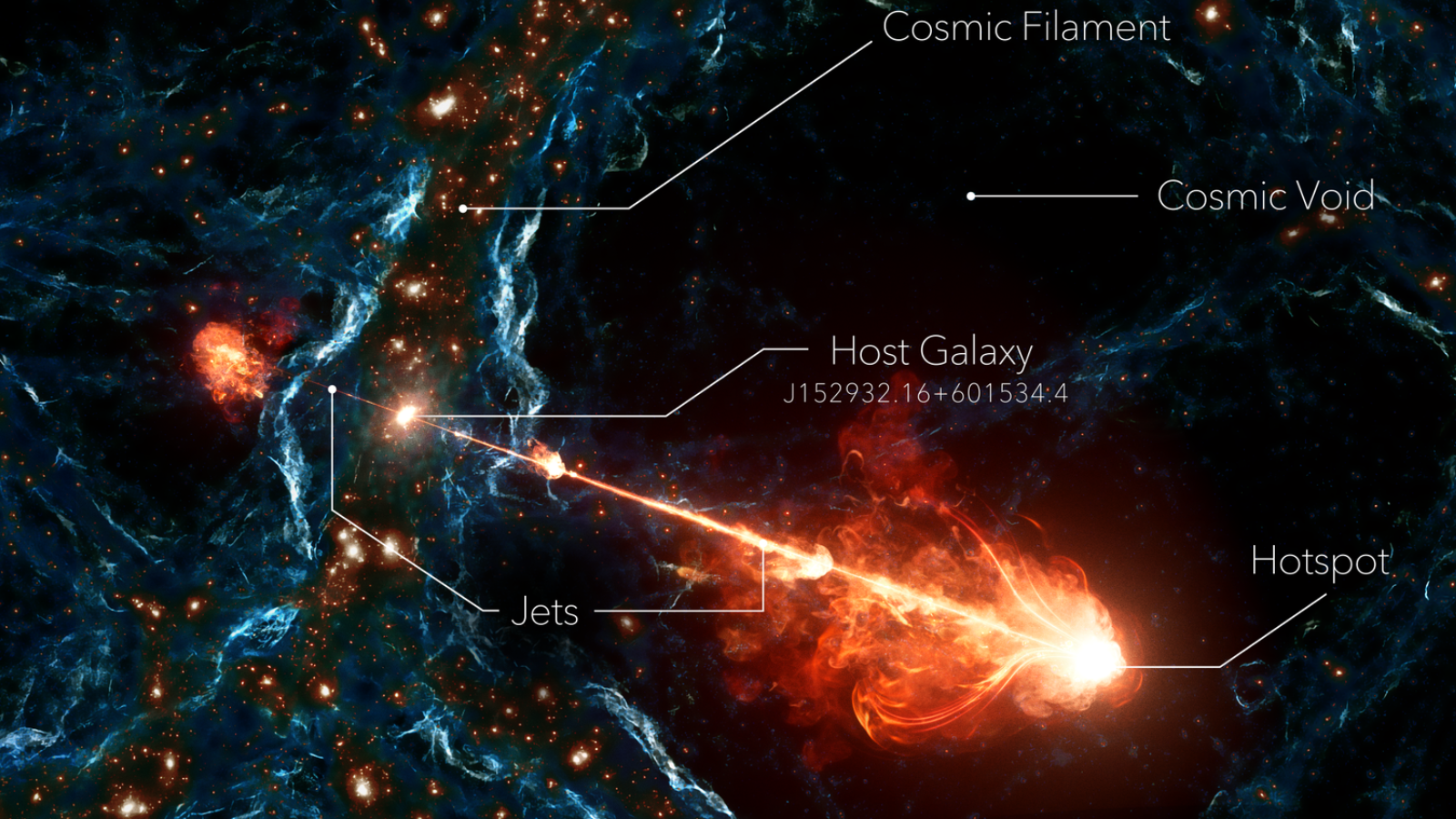
The team first began hunting black hole jets back in 2018 when they also started studying the tenuous filaments that cross the voids between galaxies which scientists call the "cosmic web." It was while hunting these faint tendrils that the team first saw several surprisingly long black hole jet structures.
When we first found the giant jets, we were quite surprised," team leader Martin Oei, a Caltech postdoctoral scholar also associated with Leiden Observatory, said. "We had no idea that there were this many."
The team used various methods to hunt jets hidden in LOFAR data, including machine learning, scanning by eye, and collaborating with citizen scientists from across the globe for double-checks.
Once the Porphyrion jets were identified, the team turned to the Giant Metrewave Radio Telescope (GMRT) and the Dark Energy Spectroscopic Instrument (DESI) to pinpoint their point of origin. They discovered the home of this supermassive black hole was a heavyweight galaxy around ten times more massive than our Milky Way. The scientists then used the W. M. Keck Observatory in Hawai'i to determine that Porphyrion originates 7.5 billion light-years from Earth.
"What else do we know about this galaxy and its central black hole? Not too much!" Hardcastle said. "We know it's a massive galaxy, and the black hole is growing fast, but we don't know why. All galactic center black holes, in principle, could make these jets, but only some do. Figuring out why is one of the key problems in this area."
Black holes had extended meal times in the early universe
Data from W.M. Keck also revealed something else about Porphyrion. The supermassive black hole from which it comes isn't actually in jet-blasting mode. Instead, the black hole is in a state called radiative mode, during which a black hole loses energy via powerful winds of particles.
Both of these states are associated with "feeding" or "accreting" black holes that are in a phase of actively gobbling matter from their surroundings and emitting energy as a result. Radiative mode was more common in the early and distant universe, where black holes were seen radiating energy, while jet-mode black holes are more common in the later and local universe, and, as the name suggests, this mode means black holes are blasting out energy as jets.
This was a shock because astronomers hadn't thought that radiative-mode black holes could launch such tremendously large jets. The mechanism that allowed this jet to last long enough to reach such lengths in the turbulent early universe is currently unknown.
"I think there are two take-home messages for me. One is that jets actually can stay switched on and stable for this long, even in the relatively early universe. It may be that this particular source just had the perfect conditions for long life, but we wouldn't have expected that at this time in the universe's history," Hardcastle said. "The other is that, since these sources can reach these large sizes, they pollute the void between the galaxies with magnetic fields and energetic particles — that could have important implications for the study of the history of magnetic fields in the universe."
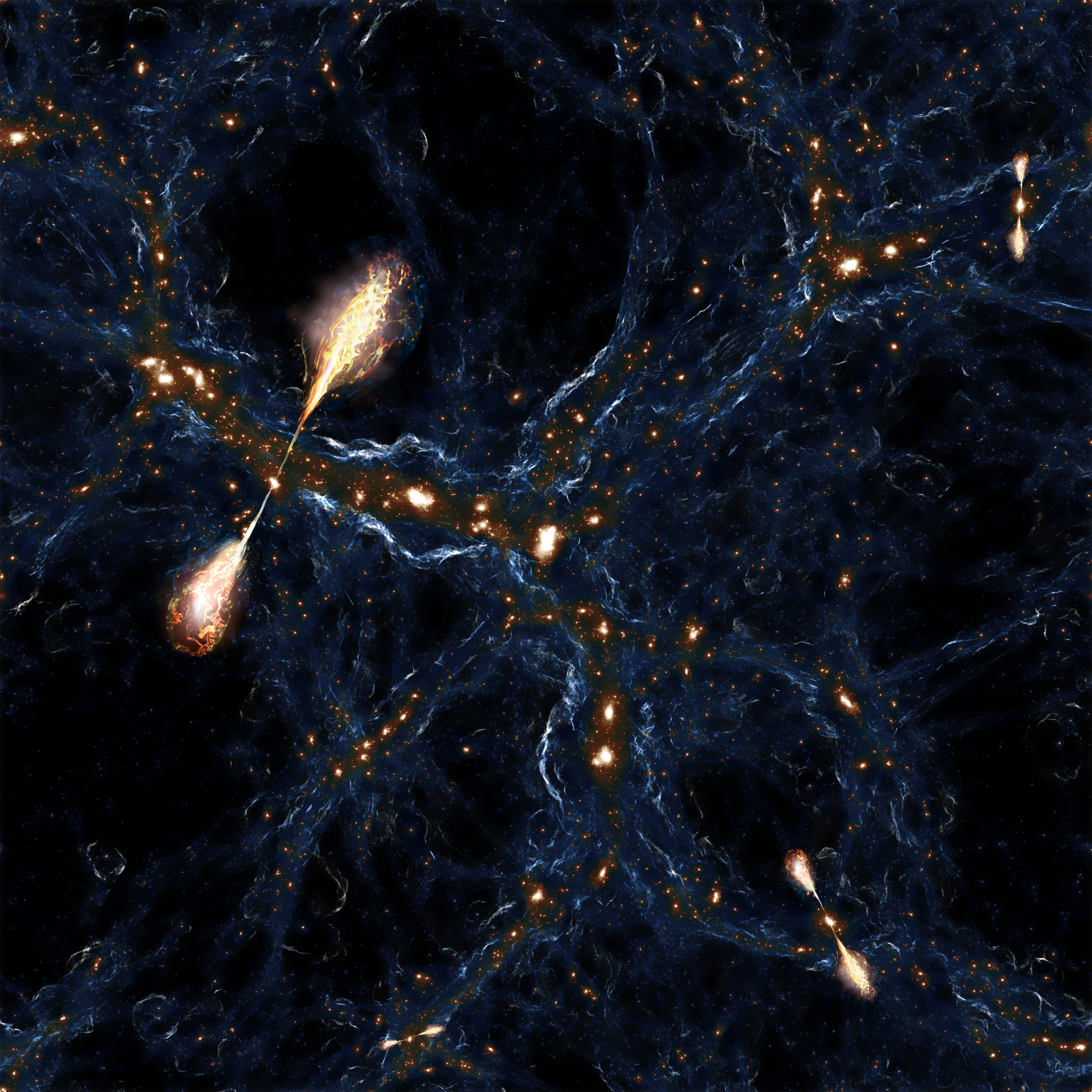
Hardcastle added that his interpretation of the size of the gargantuan jets is that it would take an unusually long-lived and stable accretion event around the central, supermassive black hole to allow it to be active for so long — about a billion years — and to ensure that the jets keep pointing in the same direction over all of that time.
"These systems grow with time, so seeing a very large source tells us that we are seeing something very old. In this case, we think the jet has been switched on for about a billion years," he said. "That's interesting because these jets normally have much shorter lives and grow to much smaller sizes.
The researcher explained that if the jets had "switched off" or if their axis had changed — which could happen through a black hole/black hole merger, for example — then the source could not have grown to this size.
"There must be something about the black hole and accretion in this system that is extremely stable," Hardcastle added. "What we're learning from the large number of giants is that this must be a relatively common occurrence."
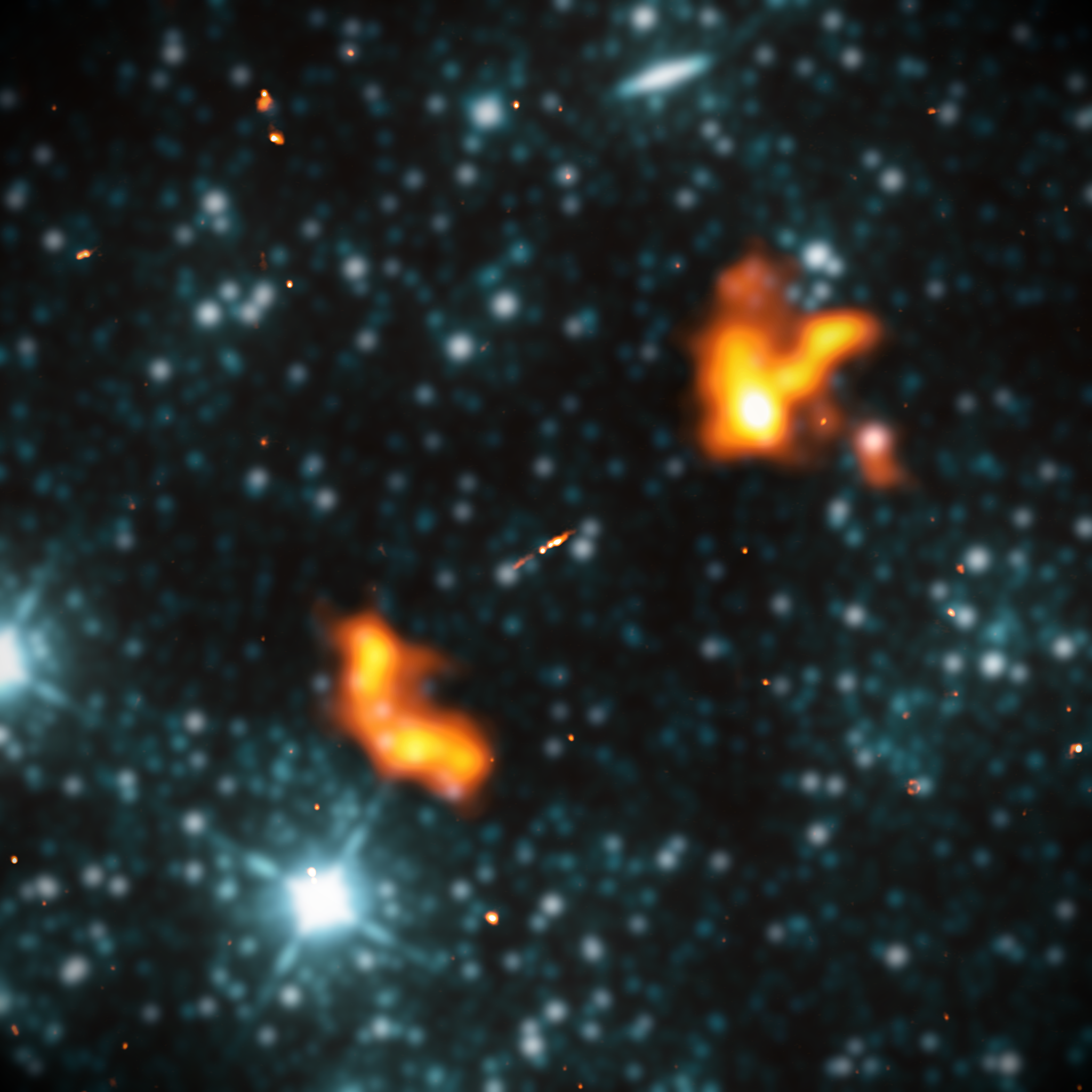
The fact that LOFAR was capable of discovering such tremendously large jets isn't, in itself, too shocking to the team.
"We've been building up to this for a while, as it's become clear that our new radio surveys were much more sensitive than the previous ones and could detect these faint and very extended sources," he said. "So, in a sense, it's not surprising at all that we have broken our own previous record for the largest one detected — but the implications for the history of the black hole and large-scale magnetic field history of the universe are still very interesting."
The team's next steps will be to investigate how these gigantic black hole jets influence their surrounding galaxies. Oei is particularly interested in the magnetic influence of these jets.
"The magnetism on our planet allows life to thrive, so we want to understand how it came to be," he said. "We know magnetism pervades the cosmic web, then makes its way into galaxies and stars, and eventually to planets, but the question is: Where does it start? Have these giant jets spread magnetism through the cosmos?"
And if the team is right, there should be plenty more massive black hole jets in the cosmos to study.
"There absolutely could be other jets of equal size or even larger by waiting to be found," Hardcastle said. "We don't know of anything in principle limiting the size of these objects, and we have only surveyed about an eighth of the sky with LOFAR so far. It and other telescopes, such as the forthcoming Square Kilometer Array, will almost certainly find something larger before we are done.
"For me, the interest of these surveys is in getting the whole population, from which we can work out the implications for the active lifetime of all black holes throughout cosmic time."
The team's research has been accepted for publication in the journal Astronomy & Astrophysics.







